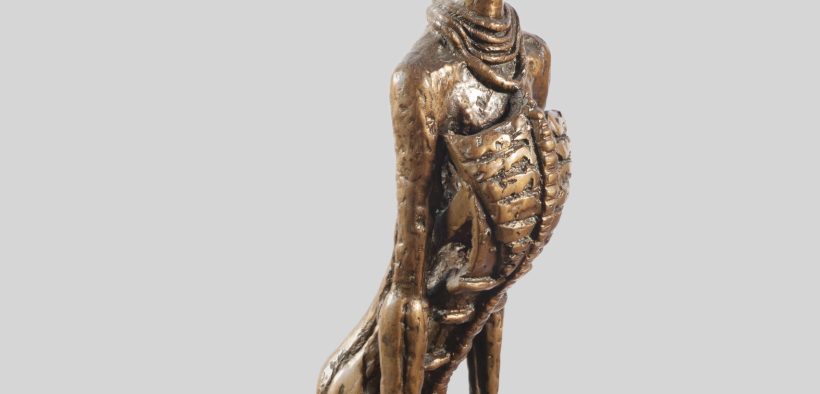kó Gallery Debuts At Frieze Masters, With Ben Enwonwu Works
Share

kó Gallery debuts at London exhibition, Frieze Masters, with Ben Enwonwu works.

While the unprecedented challenges brought forth by the coronavirus have cancelled the physical edition of Frieze London and Frieze Masters this year, kó will participate in the online edition of the Frieze Viewing Room, 9-16 October 2020. The project is included in the Spotlight section, which features solo presentations by ground-breaking artists of the twentieth century.
Ben Enwonwu was the first artist from the African continent to gain global visibility. Working as a painter and sculptor throughout Nigeria’s colonial, independence, and post-independence periods, he formed a unique modernist language that speaks to the country’s culture and national identity.
At Frieze, kó will present twelve works in oil, gouache, and wood and bronze sculpture by Enwonwu spanning the years 1940-1980. The selection focuses on several recurring themes in the artist’s work: dances, performances, and masquerades, reflective of the movements of Negritude and Pan-Africanism.
“Ben Enwonwu was a pioneer in developing a visual vocabulary for Nigerian modernism to speak on its own terms,” said Kavita Chellaram, founder of kó. “His
artworks were in conversation with modern art movements throughout Africa and
around the world. It is no surprise that his artwork has gained such renewed
international attention, cementing his legacy as one of the twentieth century’s
most important artists.”
Born in 1917 in Onitsha, Nigeria, Ben Enwonwu was trained in the first accredited formal art education program in colonial Nigeria. He received a scholarship to study at the Slade School in London, becoming its first African graduate. Ben Enwonwu quickly garnered international praise for his work. In 1949, Ebony Magazine coined him “Africa’s greatest artist”. By 1950, his work had been exhibited across four continents, in Africa, Europe, Asia, and the USA.
In 1956, Enwonwu was commissioned to produce a bronze sculpture of Queen Elizabeth II. As the first African artist to be commissioned by the Queen, the unveiling became a major international sensation. A version of his iconic sculpture of Anyanwu, the Igbo sun god, was given as a gift to the United Nations from Nigeria in 1966, where it is permanently installed today.
This presentation in the Frieze Viewing Room includes a selection of oil paintings and gouaches from Enwonwu’s series Africa Dances, which foregrounded the primacy of dance and performance as central elements of African and African diaspora cultural representation.
The showing also includes watercolours from his long-term Negritude series.
Enwonwu was invited to join the Negritude movement by Leopold Senghor, one of its founders. In Black Culture (1986), Enwonwu references the ideology of Negritude, suggesting his affinity with the artists of the Harlem Renaissance that he encountered during his exhibition and tour in the United States in 1950.
Throughout his life, Enwonwu described himself primarily as a sculptor. Also included in this presentation at Frieze is an early mahogany wood sculpture, The Boxer (1942), which uses minimalist planes and fluid forms to generate an image of an athlete in motion. Torso of a Girl (1967), an ebony wood sculpture, depicts a woman of the Fulani people. Enwonwu’s famous bronze sculpture, Anyanwu (c. 1975), whose body has been compared to the attenuated figures of European modernist artist Alberto Giacometti is based on a 16th-century Edo-Benin bronze head of a queen. Both works will be presented in the Frieze Viewing Room. Several versions of Anyanwu are located at the National Museum in Lagos, the United Nations Headquarters in New York as well as the National Museum of Zimbabwe.
The version of Anyanwu shown is signed and numbered by the artist (#3), a rare edition that has not yet come into the public domain.
Enwonwu explained the importance of Anyanwu for envisioning Nigeria’s national consciousness at the dawn of independence: “My aim was to symbolize our rising nation. I have tried to combine material, crafts, and tradition, to express a conception that is based on womanhood—woman, the mother and nourisher of man. In our rising nation, I see the forces embodied in womanhood; the beginning, and then, the development and flowering into the fullest stature of a
nation—a people! This sculpture is spiritual in conception, rhythmic in movement,
and three dimensional in its architectural setting—these qualities are
characteristic of the sculptures of my ancestors.”
Over the last few years, Enwonwu’s artworks have made international headlines with record-breaking sales at auction. One of his iconic paintings of Tutu achieved over a
million pounds at Bonhams in 2018 after it was found in a London apartment. Soon after, his painting Christine, a portrait of an African-American woman living in Lagos in the 1970s, also achieved a record sale at Sotheby’s in October 2019.
To this day, Ben Enwonwu’s artworks, critical writings, and commentary on the art of
his time continue to be among the most substantial of any modern artist in the global
context.
kó has produced a catalogue for this presentation, featuring a text by Dr. Sylvester
Okwunodu Ogbechie, Professor at University of California, Santa Barbara, and the
author of the seminal publication about the artist, Ben Enwonwu: The Making of An
African Modernist.







